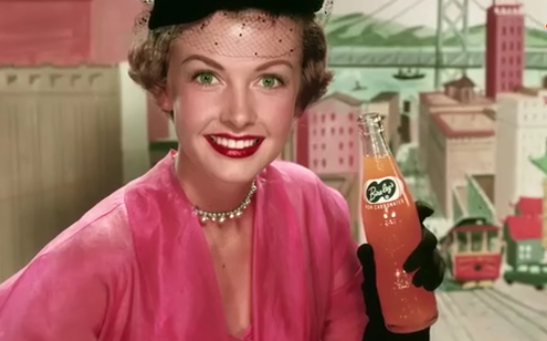原味人文風情:In 1927, Time Magazine took a survey of all the major department stores across the country. They wanted to know which colors they associated with girls in their clothing lines. The answers came back pretty mixed.
《時代雜志》在1927年對全國各大百貨公司做了一項調查。他們想了解百貨公司的服飾系列將女孩和哪些顏色相聯系。調查出來的結果五花八門。
There's also a catalogue in 1918 that suggests that little girls should all wear blue because it's a delicate and dainty color.
1918年,一本型錄建議小女孩們應該全穿藍色,因為藍色是精致優雅的顏色。
That's Jennifer Wright. She's an author and often writes about history and fashion for Racked.
它就是珍妮弗·萊特。她是位作家,經常替Racked撰寫有關歷史和時尚的文章。
It was only after the war that pink got the symbolic association that we have today.
我們現在對粉紅色的象征性聯想是到戰后才出現的。
In 1953, Dwight Eisenhower, the general who won World War II, becomes president. And this actually turns out to be a pretty important moment in the history of pink.
1953年,在二戰中取得勝利的上將德懷特·艾森豪威爾當上了總統。這其實是粉紅色歷史上非常重要的一刻。
It was Ike's inauguration, and Mamie Eisenhower came out in this enormous rhinestone-studded pink ball gown, the likes of which you never would have seen during the war when women were wearing much simpler styles.
在艾森豪威爾的就職典禮上,瑪米·艾森豪威爾身穿這件龐大、綴滿萊茵石的粉紅色禮服出場,這是在戰爭期間絕對看不到的,女性的戰時服裝風格更簡樸。
瑪米·艾森豪威爾深愛粉紅色,而且她也以此聞名。
She thought that the pink really brought out her complexion. She had really pretty blue eyes. It was a nice contrast.
她認為粉紅色十分突顯出她的膚色。她有非常漂亮的藍眼睛,呈現出完美對比。
In fact, a quick search of newspaper headlines mentioning Mamie Eisenhower also reference the color pink pretty frequently. And it wasn't just called pink—it was called "Mamie pink."
事實上,快速搜尋一下和瑪米·艾森豪威爾相關的報章標題,上面也經常提到粉紅色。而且它還不只被稱為粉紅色,而被稱為“瑪米粉紅”。
And she went around giving quotes like "Ike runs the country. I turn the pork chops." But yeah, it was a very arbitrary decision that she just loved pink and everybody else decided, Okay, this is the color that ladylike women wear. There's a great song in Funny Face called "Think Pink"...
瑪米還到處講像“艾森豪威爾治理國家,我則將豬排翻面”這樣的話。不過,嗯,這是個非常任意的決定,她剛好喜歡粉紅色,然后其他人也決定這是淑女穿的顏色。在電影《甜姐兒》中有首很棒的歌叫“想想粉紅”...
Here's our theme. Here's our answer. Pink!
這就是我們的主題。這就是我們的答案。粉紅!
...where the lady editor of the magazine who is very much based off of Diana Vreeland sings about how women in America today have gotta think pink. And there's a great line in it where she says "Banish the black. Burn the blue," which are two colors that women would have been seeing a lot of during the war years.
...以黛安娜·佛里蘭為樣本的雜志女編輯歌頌著現今的美國女性想想粉紅的必要性。電影中還有一句很棒的臺詞,她說:“把黑色趕走。把藍色燒毀。”這兩種顏色在戰爭年間的女性中很常見。
Around this time, pink became a popular color not only in just women's clothing, but also in the home.
大約在這個時候,粉紅色變成大受歡迎的顏色,不僅在女性服飾上如此,居家也是。
Pink as a bridal blush. New Camay, Loving Pink Camay, with an exciting new fragrance sealed in pink pearl foil: new Loving Pink Camay.
新娘嬌羞臉紅般的粉紅。新佳美香皂——愛戀粉紅佳美有著令人興奮的全新香氣,封存在粉色珍珠錫箔中:全新愛戀粉紅佳美香皂。

This was something a lot of women liked—by the way, it wasn't seen as a terribly oppressive thing. But, there were definitely women like Diana Vreeland who didn't really want to revert to those traditional roles.
粉紅色是許多女性的心頭好——順帶提一下,它當時并不被視為一種極度壓迫的事物。不過,當然有像黛安娜·佛里蘭這類的女性不太想回歸那些傳統女性角色。
I haven't seen a woman in two weeks in anything but pink! What about you?
我這兩個禮拜只看到身穿粉紅色衣服的女人了!你呢?
Me? I wouldn't be caught dead.
我?我死也不會穿。
It was at this point where you start to see the color pink representing women real and fictional who were anything but traditional. The champion race car driver Donna Mae Mims is a really good example of this. She had a pink uniform and a pink helmet and a pink race car. There's the pink ladies in Grease and the Plastics in Mean Girls.
就是此時,你開始看到粉紅色代表一些現實和虛構中的女性,她們絕對不傳統。冠軍賽車手唐娜·梅·米姆斯就是個絕佳范例。她有一身粉紅色的賽車服、一頂粉紅安全帽和一輛粉紅色賽車。還有電影《火爆浪子》中的粉紅女士以及《辣妹過招》的塑膠女們。
The girls who are incredibly canny and kind of terrifying, brightly explain...
那些超精明又有點兒讓人害怕的女生們鮮明地解釋...
On Wednesdays, we wear pink.
星期三的時候,我們穿粉紅色。
There's a great cover of Hillary Clinton on the cover of People magazine wearing a bright pink jacket, and the caption next to it is how we need to break the highest, hardest glass ceiling as women. So she's pretty much doing the opposite of what Mamie Eisenhower wanted to do.
希拉蕊·柯林頓在《時人》雜志封面有張身穿亮粉紅外套的出色封面照,而它下邊的標題寫著我們有多需要打破女性面臨的最高、最堅的玻璃頂棚。她幾乎在做和瑪米·艾森豪威爾完全相反的事。
This isn't just about the color pink. It's about how it's used to define a person's personality and what we think they're capable of.
這不僅是粉紅色的問題。它還和粉紅色如何定義一個人的個性與被認為具備的能力有關。
She still wants to show people that, Really, I'm just a girl, just like you.
她還想讓人們看到,真的,我只是個女生,就和你們一樣。












